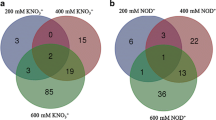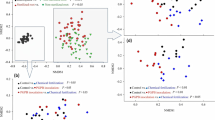Abstract
Background and aims
Casuarina glauca is an actinorhizal plant that establishes root-nodule symbiosis with N2-fixing bacteria of the genus Frankia. This plant is highly recalcitrant to extreme environmental conditions such as salinity and drought. The aim of this study was to evaluate the impact of salt stress on the symbiotic relationship between C. glauca and Frankia Thr, focusing on N and C metabolism.
Methods
Symbiotic and non-symbiotic plants were exposed to 0, 200, 400 and 600 mM NaCl. The following analyses were performed: stable carbon (δ13C) and nitrogen (δ15N) isotope signature; nitrogenase activity in nodules (acetylene reduction assay); and gene expression of a set of genes involved in nodule infection and N/C metabolism (qRT-PCR). Data were analysed using two-way ANOVA.
Results
Salt stress induced an enrichment in δ13C and δ15N, reflecting a negative impact of salt in the relative water content and N2 fixation, respectively. Furthermore, nitrogenase activity in nodules was insignificant already at 200 mM NaCl, consistent with the expression patterns of nifH as well as of plant genes involved in nodule induction and metabolism.
Conclusions
The ability of C. glauca to thrive under highly saline environments is not dependent on the symbiosis with Frankia.


Similar content being viewed by others
References
Amor FM, Cuadra-Crespo P (2011) Alleviation of salinity stress in broccoli using foliar urea or methyl-jasmonate: analysis of growth, gas exchange, and isotope composition. Plant Growth Regul 63:55–62
Batista-Santos P, Duro N, Rodrigues AP, Semedo JN, Alves P, da Costa M, Graça I, Pais IP, Scotti-Campos P, Lidon FC, Leitão AE, Pawlowski K, Ribeiro-Barros AI, Ramalho JC (2015) Is salt stress tolerance in Casuarina glauca Sieb. ex Spreng. associated with its nitrogen-fixing root-nodule symbiosis? An analysis at the photosynthetic level. Plant Physiol Biochem 96:97–109
Brugnoli E, Lauteri M (1991) Effects of salinity on stomatal conductance, photosynthetic capacity, and carbon isotope discrimination of salt-tolerant (Gossypium hirsutum L.) and salt-sensitive (Phaseolus vulgaris L.) C3 non-halophytes. Plant Physiol 95:628–635
Burchett MD, Clarke CJ, Field CD, Pulkownik A (1989) Growth and respiration in two mangrove species at a range of salinities. Physiol Plant 75:299–303
Carro-Garcia L, Pujic P, Alloisio N, Fournier P, Boubakri H et al (2015) Alnus peptides modify membrane porosity and induce the release of nitrogen-rich metabolites from nitrogen-fixing Frankia. ISME J 9:1723–1733
Carter JL, Colmer TD, Veneklaas EJ (2006) Variable tolerance of wetland tree species to combined salinity and waterlogging is related to regulation of ion uptake and production of organic solutes. New Phytol 126:123–134
Cernusak LA, Winter K, Turner BL (2009) Plant δ15N correlates with the transpiration efficiency of nitrogen acquisition in tropical trees. Plant Physiol 151:1667–1676
Chaves MM, Flexas J, Pinheiro C (2009) Photosynthesis under drought and salt stress: regulation mechanisms from whole plant to cell. Ann Bot 103:551–560
Cramer VA, Schmidt S, Stewart GR, Thorburn PJ (2002) Can the nitrogenous composition of xylem sap be used to assess salinity stress in Casuarina glauca? Tree Physiol 22:1019–1026
da Costa M, Duro N, Batista-Santos P, Ramalho JC, Ribeiro-Barros A (2015) Validation of candidate reference genes for qRT-PCR studies in symbiotic and nonsymbiotic Casuarina glauca Sieb. ex Spreng. under salinity conditions. Symb 66: 21-35
Demina IV, Persson T, Santos P, Plaszczyca M, Pawlowski K (2013) Comparison of the nodule vs. root transcriptome of the actinorhizal plant Datisca glomerata: actinorhizal nodules contain a specific class of defensins. PLoS One 8:e72442
Diem HG, Dommergues YR (1990) Current and potential uses and management of Casuarinaceae in tropics and subtropics. In: Schwintzer CR, Tjepkma JD (eds) The biology of Frankia and actinorhizal plants. Academic, San Diego, pp 317–342
Evans RD (2001) Physiological mechanism influencing plant nitrogen isotope composition. Trends Plant Sci 6:121–126
Fortunato A, Santos P, Graça I, Gouveia M, Martins S et al (2007) Isolation and characterization of cgchi3, a nodule-specific gene from Casuarina glauca encoding a class III chitinase. Physiol Plant 130:418–426
Ghoulam C, Foursy A, Fares K (2002) Effects of salt stress on growth, inorganic ions and proline accumulation in relation to osmotic adjustment in five sugar beet cultivars. Environ Exp Bot 47:39–50
Hafeez FY, Hameed S, Malik KA (1999) Frankia and Rhizobium strains as inoculum for fast growing trees in saline environment. Pak J Bot 31:173–182
Hardy RW, Burns RC, Holsten RD (1973) Application of the acetylene essay for measurement of N2 fixation. Soil Biol Biochem 5:47–81
Hasegawa PM, Bressan RA, Zhu JK, Bohnert HJ (2000) Plant cellular and molecular responses to high salinity. Annu Rev Plant Physiol Plant Mol Biol 51:463–499
He X, Xu M, Qui GY, Zhou J (2009) Use of 15N stable isotope to quantify nitrogen transfer between mycorrhizal plants. J Plant Ecol 2:107–118
Hocher V, Alloisio N, Auguy F, Fournier P, Doumas P et al (2011) Transcriptomics of actinorhizal symbioses reveals homologs of the whole common symbiotic signaling cascade. Plant Physiol 156:700–711
Hwang YH, Morris JT (1994) Whole-plant gas-exchange responses of Spartina alterniflora (Poaceae) to a range of constant and transient salinities. Am J Bot 81:659–665
Kasai K, Fukayama H, Ucghida N, Mori N, Yasuda T et al (1998) Salinity tolerance in Triticum aestivum, Lophopyrum elongatum amphiploid and 5E disomic addition line evaluated by NaCl effects on photosynthesis and respiration. Cereal Res Commun 26:281–287
Kozlowski TT (1997) Responses of woody plants to flooding and salinity. Tree Physiol Monogr 1:1–29
Kratsch HA, Graves WR (2004) Location and anatomy of nodules on Alnus maritima subjected to flooding. J Am Soc Hortic Sci 129:775–780
Lam H-M, Coschigano KT, Oliveira IC, Melo-Oliveira R, Coruzzi G (1996) The molecular-genetics of nitrogen assimilation into amino acids in higher plants. Annu Rev Plant Physiol Plant Mol Biol 47:569–593
Laplaze L, Ribeiro A, Franche C, Duhoux E, Auguy F et al (2000a) Characterization of a Casuarina glauca nodule-specific subtilisin-like protease gene, a homologue of Alnus glutinosa ag12. Mol Plant-Microbe Interact 13:113–117
Laplaze L, Ribeiro-Barros AI, Franche C, Duhoux E, Auguy F et al (2000b) Characterization of a Casuarina glauca nodule-specific subtilisin-like protease gene, a homolog of Alnus glutinosa ag12. MPMI 13:113–117
Lea PJ, Mifflin BJ (1980) Transport and metabolism of asparagine and other compounds within the plant. In: Mifflin BJ (ed) The biochemistry of plants, vol. 5. Academic, New York, pp 569–607
McNally SF, Hirel B (1983) Glutamine synthetase isoforms in higher plants. Physiol Veg 21:761–774
Mora C, Wei C-L, Rollo A, Amaro T, Baco AR et al (2013) Biotic and human vulnerability to projected changes in ocean biogeochemistry over the 21st century. PLoS Biol 11(10), e1001682
Morant-Manceau A, Pradier E, Tremblin G (2004) Osmotic adjustment, gas exchanges and chlorophyll fluorescence of a hexaploid triticale and its parental species under salt stress. J Plant Physiol 161:25–33
Munns R (2005) Genes and salt tolerance: bringing them together. New Phytol 167:645–663
Munns R, Tester M (2008) Mechanisms of salinity tolerance. Annu Rev Plant Biol 59:651–681
Olea F, Pérez-García A, Cantón FR, Rivera ME, Cañas R et al (2004) Up-regulation and localization of asparagine synthetase in tomato leaves infected by the bacterial pathogen Pseudomonas syringae. Plant Cell Physiol 45:770–780
Oshone R, Mansour SR, Tisa LS (2013) Effect of salt stress on the physiology of Frankia sp strain CcI6. J Biosci 38:699–702
Oyedotun KS, Lemire BD (2004) The quaternary structure of the Saccharomyces cerevisiae succinate dehydrogenase. Homology modeling, cofactor docking, and molecular dynamics simulation studies. J Biol Chem 279:9424–9431
Pancholi V (2001) Multifunctional alpha-enolase: its role in diseases. Cell Mol Life Sci 58:902–920
Pawlowski K, Bisseling T (1996) Rhizobial and actinorhizal symbiosis: what are the shared features? Plant Cell 8:1899–1913
Pritchard ES, Guy RD (2005) Nitrogen isotope discrimination in white spruce fed with low concentrations of ammonium and nitrate. Trees 19:89–98
Ramalho JC, Zlatev ZS, Leitão AE, Pais IP, Fortunato AS et al (2014) Moderate water stress causes differential stomatal and non-stomatal changes on the photosynthetic functioning of Phaseolus vulgaris L. genotypes. Plant Biol 16:133–146
Rascher KG, Maguas C, Werner C (2010) On the use of phloem sap δ13C as an indicator of canopy carbon discrimination. Tree Physiol 13:1499–1514
Rascher KG, Hellmann C, Maguas C, Werner C (2012) Community scale 15N isoscapes: tracing the spatial impact of an exotic N2-fixing invader. Ecol Lett 15:484–491
Rozen S, Skaletsky H (2000) Primer3 on the www for general users and for biologist programmers. Methods Mol Biol 132:365–386
Sampaio L, Freitas R, Máguas C, Rodrigues A, Quintino V (2010) Coastal sediments under the influence of multiple organic enrichment sources: An evaluation using carbon and nitrogen stable isotopes. Marine Poll Bull 60:272–282
Santos P, Fortunato A, Graça I, Martins SM, Gouveia MM et al (2010) Characterization of four defense-related genes expressed in root nodules of Casuarina glauca. Symbiosis 50:27–35
Shi L, Twary SN, Yoshioka H, Gregerson RG, Miller SS et al (1997) Nitrogen assimilation in alfalfa: isolation and characterization of an asparagine synthetase gene showing enhanced expression in root nodules and dark-adapted leaves. Plant Cell 9:1339–1356
Sieciechowicz KA, Joy KW, Ireland RJ (1988) Diurnal changes in asparaginase activity in pea leaves. I. The requirement for light for increased activity. J Exp Bot 39:695–706
Srivastava A, Singh SS, Mishra AK (2012) Sodium transport and mechanism(s) of sodium tolerance in Frankia strains. J Basic Microbiol 52:1–2
Svistoonoff S, Laplaze L, Liang J, Ribeiro A, Gouveia MC et al (2004) Infection-Related Activation of the cg12 Promoter Is Conserved between Actinorhizal and Legume-Rhizobia Root Nodule Symbiosis1. Plant Physiol 136:3191–3197
Tani C, Saskkawa H (2003) Salt tolerance of Casuarina equisetifolia and Frankia Ceq1 strain isolated from root nodules of C. equisetifolia. Soil Sci Plant Nutr 49:215–222
Tcherkez G (2011) Natural 15 N/14 N isotope composition in C3 leaves: are enzymatic isotope effects informative for predicting the 15 N-abundance in key metabolites? Funct Plant Biol 38:1–12
Tromas A, Parizot B, Diagne N, Champion A, Hocher V, Cissoko M, Crabos A, Prodjinoto H, Lahouze B, Bogusz D, Laplaze L, Svistoonoff S (2012) Heart of endosymbioses: transcriptomics reveals a conserved genetic program among arbuscular mycorrhizal, actinorhizal and legume-rhizobial symbioses. PLoS ONE 7(9), e44742
Valverde C, Wall LG (2003) Ammonium assimilation in Discaria trinervis root nodules. Regulation of enzyme activities and protein levels by the availability of macronutrients (N, P and C). Plant Soil 254:139–153
van Groenigen JW, van Kessel C (2002) Salinity-induced patterns of natural abundance carbon-13 and nitrogen-15 in plant and soil. Soil Sci Soc Am J 66:489–498
Vojnović S, Ilić-Tomić T, Savić M, Bajkić S, Morić I et al (2010) Comparative analysis of 16S rRNA methyltransferases conferring resistance to amynoglycoside antibiotics in producing strains. In: Vilas AM (ed) Current research, technology and education topics in applied microbiology and microbial biotechnology, vol 1. Formatex Research Center, Spain, pp 501–508
Wang W, Vinocur B, Altman A (2003) Plant responses to drought, salinity and extreme temperatures: towards genetic engineering for stress tolerance. Planta 218:1–14
Weigand G, Remington SJ (1986) Citrate synthase: structure, control and mechanism. Annu Rev Biophysi Biophys Chem 15:97–117
Wheeler CT, Tilak M, Scrimgeour CM, Hooker JE, Handley LL (2010) Effects of symbiosis with Frankia and arbuscular mycorrhizal fungus on the natural abundance of 15N in four species of Casuarina. J Exp Bot 51:287–297
Yousfi S, Serret MD, Araus JL (2009) Shoot δ15N gives a better indication than ion concentration or δ13C of genotypic differences in the response of durum wheat to salinity. Funct Plant Biol 36:144–155
Zhong C, Zhang Y, Chen Y, Jiang Q, Chen Z et al (2010) Casuarina research in China. Symbiosis 50:107–114
Acknowledgments
This work was supported by Fundação para a Ciência e Tecnologia under the scope of the project PTDC/AGR-FOR/4218/2012 and grant SFRH/BPD/78619/2011 (P. Batista-Santos). The authors acknowledge Paula Alves for technical assistance.
Competing interests
The authors declare that they have no competing interests.
Author information
Authors and Affiliations
Corresponding author
Additional information
Responsible Editor: Timothy J. Flowers.
Nuno Duro and Paula Batista-Santos contributed equally to this work.
Rights and permissions
About this article
Cite this article
Duro, N., Batista-Santos, P., da Costa, M. et al. The impact of salinity on the symbiosis between Casuarina glauca Sieb. ex Spreng. and N2-fixing Frankia bacteria based on the analysis of Nitrogen and Carbon metabolism. Plant Soil 398, 327–337 (2016). https://doi.org/10.1007/s11104-015-2666-3
Received:
Accepted:
Published:
Issue Date:
DOI: https://doi.org/10.1007/s11104-015-2666-3




